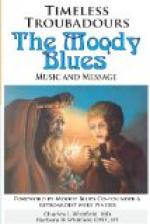Reference has already been made to the chanso. A poetical form of much importance was the sirventes, which outwardly was indistinguishable from the chanso. The meaning of the term is unknown; some say that it originally implied a poem composed by “servants,” poets in the service of an overlord; others, that it was a poem composed to the tune of a [31] chanso which it thus imitated in a “servile” manner. From the chanso the sirventes is distinguished by its subject matter; it was the vehicle for satire, moral reproof or political lampooning. The troubadours were often keenly interested in the political events of their time; they filled, to some extent, the place of the modern journalist and were naturally the partisans of the overlord in whose service or pay they happened to be. They were ready to foment a war, to lampoon a stingy patron, to ridicule one another, to abuse the morality of the age as circumstances might dictate. The crusade sirventes[14] are important in this connection, and there were often eloquent exhortations to the leaders of Christianity to come to the rescue of Palestine and the Holy Sepulchre. Under this heading also falls the planh, a funeral song lamenting the death of a patron, and here again, beneath the mask of conventionality, real emotion is often apparent, as in the famous lament upon Richard Coeur de Lion composed by Gaucelm Faidit.
Reference has been already made to the tenso, one of the most characteristic of Provencal lyric forms. The name (Lat. tentionem) implies a contention or strife, which was conducted in the form of a dialogue and possibly owed its origin to the custom in early vogue among many different peoples of holding poetical tournaments, in which one [32] poet challenged another by uttering a poetical phrase to which the opponent replied in similar metrical form. Such, at any rate, is the form of the tenso; a poet propounds a theme in the first stanza and his interlocutor replies in a stanza of identical metrical form; the dispute usually continues for some half dozen stanzas. One class of tenso was obviously fictitious, as the dialogue is carried on with animals or even lifeless objects, such as a lady’s cloak, and it is possible that some at least of the discussions ostensibly conducted between two poets may have emanated from the brain of one sole author. Sometimes three or four interlocutors take part; the subject of discussion was then known as a joc partit, a divided game, or partimen, a title eventually transferred to the poem itself. The most varied questions were discussed in the tenso, but casuistical problems concerning love are the most frequent: Is the death or the treachery of a loved one easier to bear? Is a lover’s feeling for his lady stronger before she has accepted him or afterwards? Is a bad noble or a poor but upright man more worthy to find favour? The discussion of such questions provided an opportunity of displaying both poetical dexterity and also dialectical acumen. But rarely did either of the disputants declare himself convinced or vanquished by his opponents’ arguments the question [33] was left undecided or was referred by agreement to an arbitrator.




